The groups of pendants.
Let us now return to the cave. As we go in, the first series is on the left hand side of the vestibule,
close to the entrance. It is made up three items, two elongated and a third almost rectangular with rounded faces and angles.
Five other pendants are located in the area leading to the inner room, in an area covering approximately four square metres, delimited by blocks of stone. Three of these, made from wild goat incisors and decorated, are situated close to one another. But of all the pieces the most beautiful is the pendant carved into a slender deep black pebble, whose natural outline is reminiscent of several classical Palaeolithic "Venus" figures.
Very close to this pendant there is another, blackish in colour, shaped somewhat like the atrophied canine tooth of a deer, although considerably larger. The stone was probably chosen precisely because of this similarity and the symbolism of the original object.
It was in the first of the inner rooms, however, that one of the most spectacular finds from the Palaeolithic era was made: a long necklace, one and half metres long, comprising fourteen blackstone pendants, lain, perhaps intentionally, on the clay floor. The constituent parts, most of which are decorated and elongated in shape, are arranged in orderly fashion, at regular distances. The two ends are finished off with small undecorated stones with natural holes.
gipuzkoakultura.net


gipuzkoakultura.net
miércoles 31 diciembre 2025
Bertan > The Magdalenian pendants of the Praileaitz I cave(Deba) > Versión en Inglés: The groups of pendants
- 6- Ritual activities
- 7- The process of manufacturing pendants
- 8- The groups of pendants
- 9- Who lived in Praileaitz I?
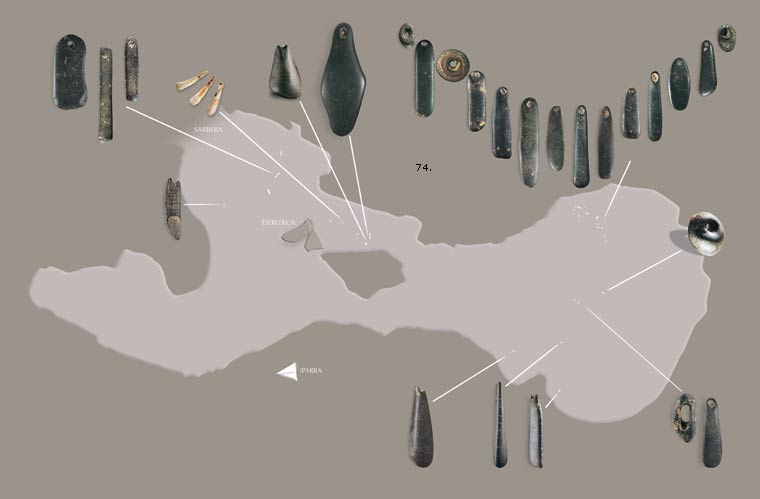
74. General position of The groups of pendants in the two excavated rooms of the cave. © Jesús Alonso
In the same room, about four metres from the first set, there is a two piece necklace.
As well as these five groupings, at several points in both the vestibule and in the inner room, there is a series of pendants broken at the perforation holes. These pendants lie relatively close together.
On all pages containing descriptions of pendants, drawings are shown to a scale of 1:1 (life size) and photos to a scale of 1:1.5 (i.e. 50% larger than their real size), to make it easier to appreciate the details. .
As well as these five groupings, at several points in both the vestibule and in the inner room, there is a series of pendants broken at the perforation holes. These pendants lie relatively close together.
On all pages containing descriptions of pendants, drawings are shown to a scale of 1:1 (life size) and photos to a scale of 1:1.5 (i.e. 50% larger than their real size), to make it easier to appreciate the details. .

75. First set consisting of three pendants. The pre-dominantly elongated shape of two of the pendants contrasts with the subrectangular form of the third. The texture and colour of the last one (brighter and blacker) is also different to the other two. Only one of them is decorated. 76. This first group was found near the entrance to the cave, next to the seat and hearth. 77. This is one of the few undecorated pendants. It is made from a levelled pebble. There is a gentle curve in one side and the angles are slightly rounded. In the area of the hole there are a series of short incisions which might be interpreted as being lines of flight. © Jesús Alonso
These are the only pieces from a necklace which are not made out of stone. They are three incisors of Capra pyrenaica (the Pyrenean wild goat) with two holes in the root, and the vestibular face is decorated with a number of short transversal incisions. They are believed to have been coloured with ochre or at least have come into contact with the material, since one of them was found with remains of red colouring.
The use of teeth from herbivores or carnivores to make pendants was common practise throughout the prehistoric period, when they were drilled and decorated with different motifs. However, there are few examples like this of teeth with more than one hole, although some incisors of horse and deer have been found, decorated and with double holes (some with as many as five) in different Magdalenian levels along the Cantabrian coast and in the Northern Pyrenean area, such as Ermittia (Deba, Gipuzkoa), Arenaza (Galdames, Bizkaia), Isturitz (Izturitze-Donamartiri, Nafarroa Behera), Mas d’Azil (Ariège) and Tito Bustillo (Ribadesella, Asturias).
Human representations are scarce in parietal art and art mobilier. Amongst the latter, particularly interesting are some scenes such as those found in the Bone of Torre (Oiartzun, Gipuzkoa) and the staff from La Vache (Ariège), or the few Venus depictions that have been found: the head of Entrefoces (Morcín, Asturias), the uncertain pendant or perforated staff from El Pendo (Camargo, Cantabria) and “The Venus” of Las Caldas (Oviedo, Asturias). The depiction of the woman, over which greater care has been taken than that of the man, is generally schematic and certain parts of the anatomy are underscored. Interpretations vary: they may represent figures of mother goddesses, votive fertility offerings, testimony of the importance of the role played by women in Palaeolithic society, etc.
The discovery of a series of pendants with break ages, generally around the area of the perforation hole, is interesting. We do not know how and when these breakages were caused; however, broken or destroyed items dating from throughout prehistory have often been found in a range of habitational and funerary contexts, and it has been suggested that they may have formed part of certain ritual practices. In the case of the pendants from Praileaitz I we do not know whether the breakage and the concentration of the items found is random or due to some other factor.
The use of teeth from herbivores or carnivores to make pendants was common practise throughout the prehistoric period, when they were drilled and decorated with different motifs. However, there are few examples like this of teeth with more than one hole, although some incisors of horse and deer have been found, decorated and with double holes (some with as many as five) in different Magdalenian levels along the Cantabrian coast and in the Northern Pyrenean area, such as Ermittia (Deba, Gipuzkoa), Arenaza (Galdames, Bizkaia), Isturitz (Izturitze-Donamartiri, Nafarroa Behera), Mas d’Azil (Ariège) and Tito Bustillo (Ribadesella, Asturias).
Human representations are scarce in parietal art and art mobilier. Amongst the latter, particularly interesting are some scenes such as those found in the Bone of Torre (Oiartzun, Gipuzkoa) and the staff from La Vache (Ariège), or the few Venus depictions that have been found: the head of Entrefoces (Morcín, Asturias), the uncertain pendant or perforated staff from El Pendo (Camargo, Cantabria) and “The Venus” of Las Caldas (Oviedo, Asturias). The depiction of the woman, over which greater care has been taken than that of the man, is generally schematic and certain parts of the anatomy are underscored. Interpretations vary: they may represent figures of mother goddesses, votive fertility offerings, testimony of the importance of the role played by women in Palaeolithic society, etc.
The discovery of a series of pendants with break ages, generally around the area of the perforation hole, is interesting. We do not know how and when these breakages were caused; however, broken or destroyed items dating from throughout prehistory have often been found in a range of habitational and funerary contexts, and it has been suggested that they may have formed part of certain ritual practices. In the case of the pendants from Praileaitz I we do not know whether the breakage and the concentration of the items found is random or due to some other factor.
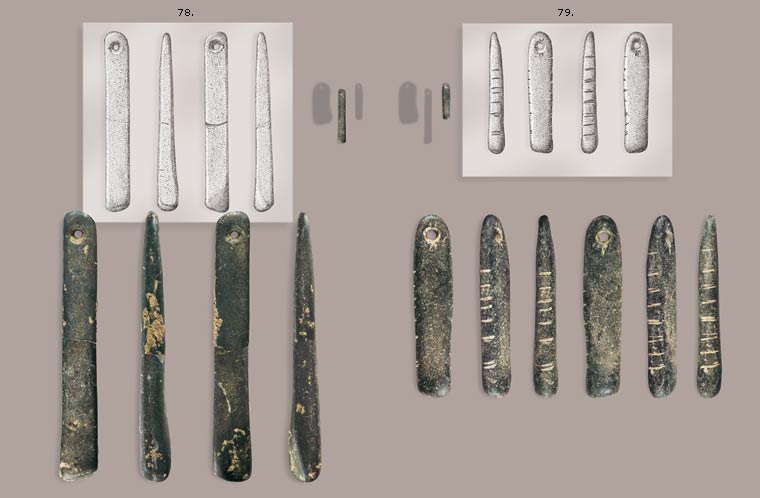
78. This piece is unusually long and almost square in cross section. It was found in two fragments, on either side of the lower face of the large rock that had come away from the southern wall of the entrance. 79. Most of the pendants are decorated in different ways with small incisions of varying depth. Some have a few marks on one of the larger sides; on others, all of one side or even the two sides are carved at approximately equal distances. The empty spaces, rhythm and pairings of the lines often form fanciful designs. © Jesús Alonso
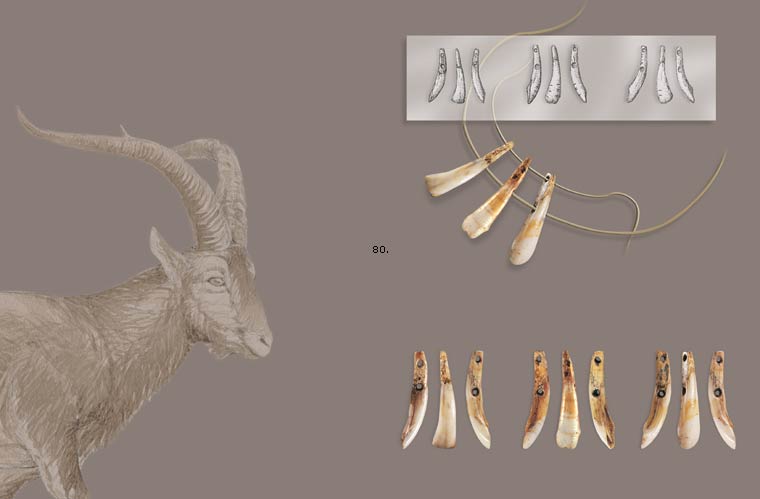
80. Two fine parallel strips of animal or plant origin would have been passed through the double hole drilled with great precision in each of the incisors to fix the position of the tooth, so that the decorative engravings would be visible. © Jesús Alonso
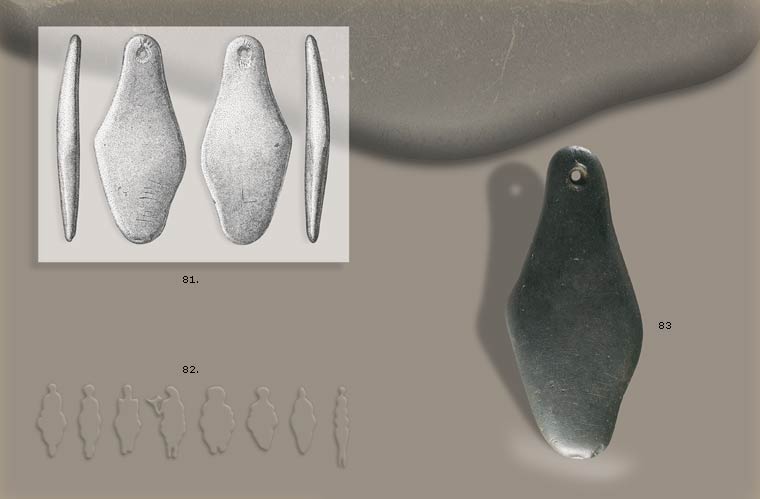
81. Third necklace made of a single drilled stone with gentle curves. The only decoration consists of a number of parallel transverse lines, lightly marked at the bottom right of each face. 82. The outline of the piece is reminiscent of the rounded Palaeolithic “Venus” figurines found in sev-eral locations throughout Europe. Examples include the figure found in Barma Grande, Grimaldi, The “Lozenge”, also from Grimaldi (Italy), Venus I from Willendorf (Austria), the Kostienki Venus (Russia) and the Lespugue Venus (France), or the outline of the relief of the Venus with Horn from Laussel (France). 83. At the narrower end there is a bi-conical drilled hole, finished off with very regular rotation; at an earlier phase the surface had been cleared or pre-pared. © Jesús Alonso
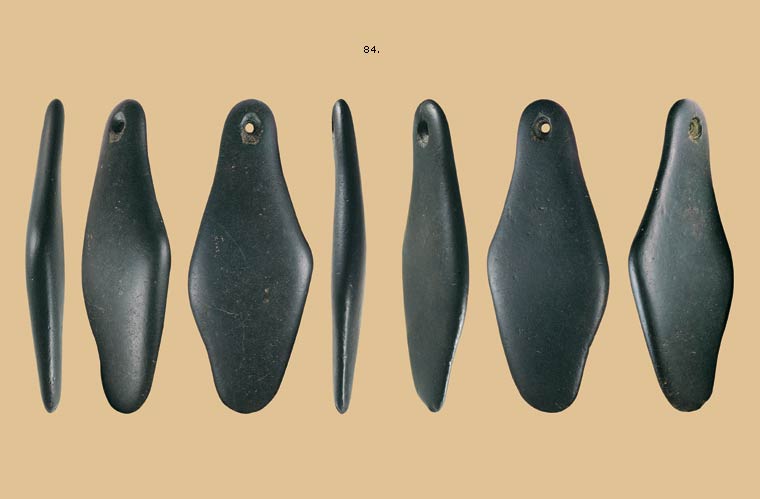
84. This thin bright black pebble would have been chosen to make into a pendant for its outline, the balance of its dimensions and its special texture. © Jesús Alonso
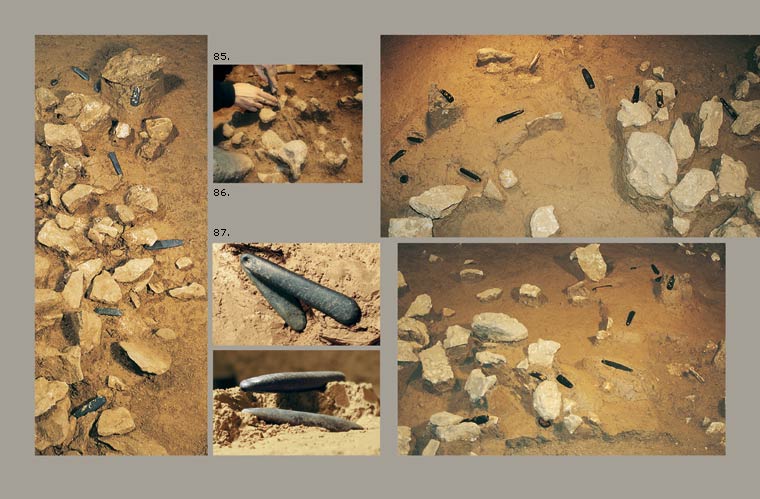
85. The fourteen black stones that make up the largest necklace found in the cave gradually emerge, looking as if they had been gently laid on the ground. 86. Detail of excavation of one of the pendants. 87. During excavation of the necklace two of the elongated pendants were found just over one centimetre apart, their holes superimposed. © Xabi Otero
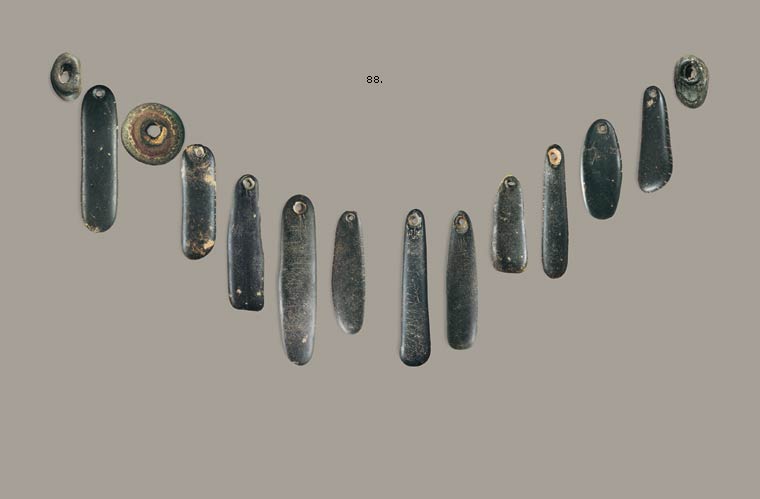
88. The combination of the shapes, the predominantly black colour and the decorations of the pieces in this large necklace make it unique of its kind. Its elaborate design shows the great sensitivity of these populations of Cro-Magnon people from the Magdalenian period. © Xabi Otero
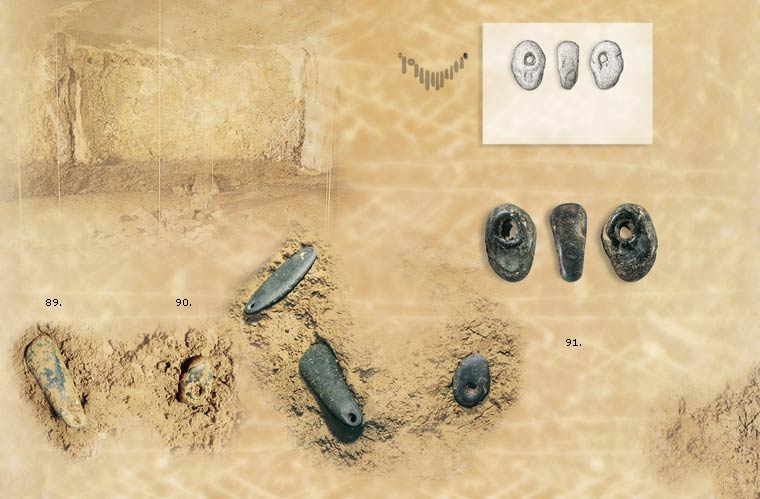
89. As the dig progresses, the fourteen pieces of this necklace from the inner room which lie close to each other, at approximately equal distances in most cases, encased in the yellow clay or interspersed between stones reveal an arrangement which makes it possible to visualise both the structure and the dimensions. 90. Detail of three of the pendants from one end of the large necklace laid on the clay in the inner room. 91. In five cases small naturally rounded and perforated stones have been inserted into the necklaces in this cavity. None of them are decorated. Three of them form part of this set. © Xabi Otero
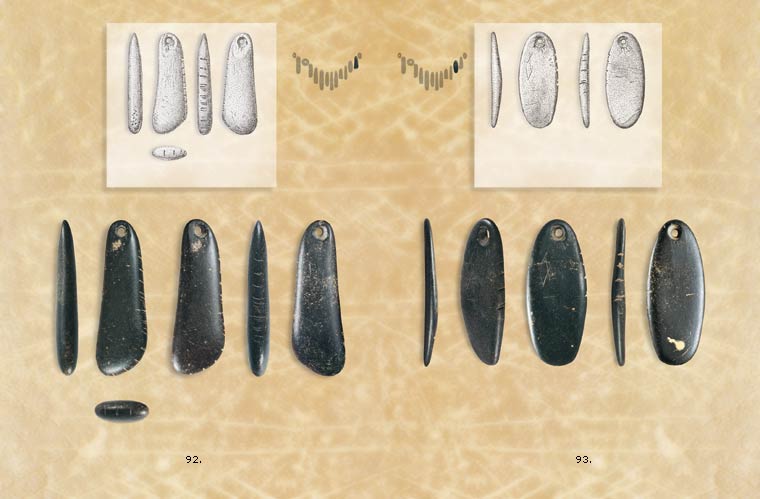
92. The incisions on the sides of the pieces include some very varied compositions, some of whichas in this case are very elaborate. We do not know what the purpose of any of these was. 93. Although the transverse markings are the most common, it is significant that as well as the motif already mentioned, this pendant also includes a rhombus with fine incisions. This motif, which on occasions has a longitudinal stroke inside, is often found on Magdalenian spears. © Jesús Alonso
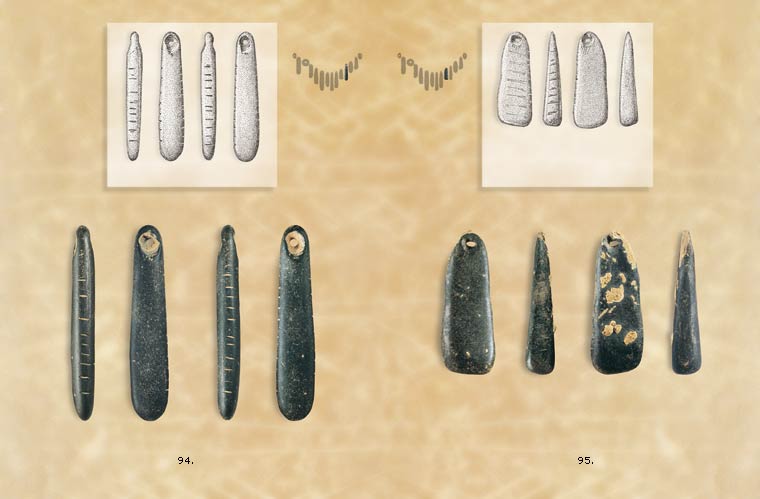
94. One important question still remains regarding the authorship of these pendants: were they the work of a single individual or various people? If we look at the workmanship and style of the different pieces, they could all have been made by the same person; despite the variations, they form an artistic and symbolic whole. 95. In some cases it is not easy to work out how many strokes were actually intended. Some of them are so close together that one may be an attempt to rectify the other. In other cases, though, the sole purpose seems to have been to suggest the lines without actually making them any more explicit. © Jesús Alonso
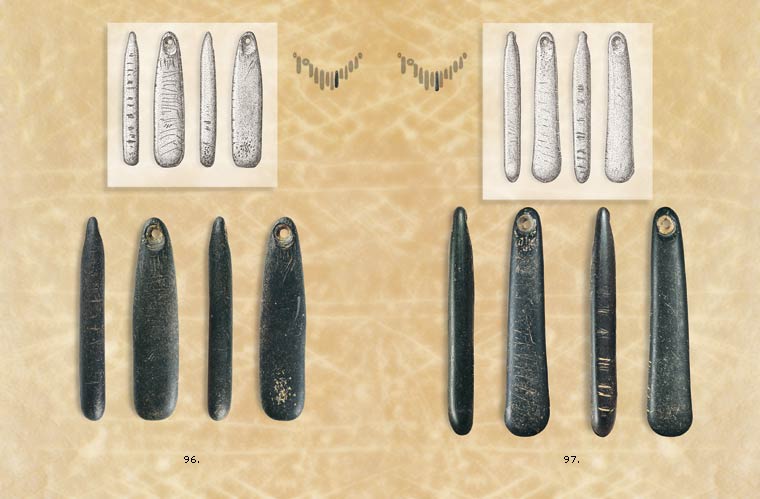
96. This pendant has a series of shaping grooves around the hole and transverse incisions on one side face, as well as on one of the larger faces. The bottom of the opposite face is covered in intense pricking, caused by the pressure of a harder object when the pendant was used as a retoucher or compressor. 97. In this pendant we can clearly see the changes in rhythm and the groupings of the incisions. However, the parallel lines are much more regularly distributed on one of the larger sides. © Jesús Alonso
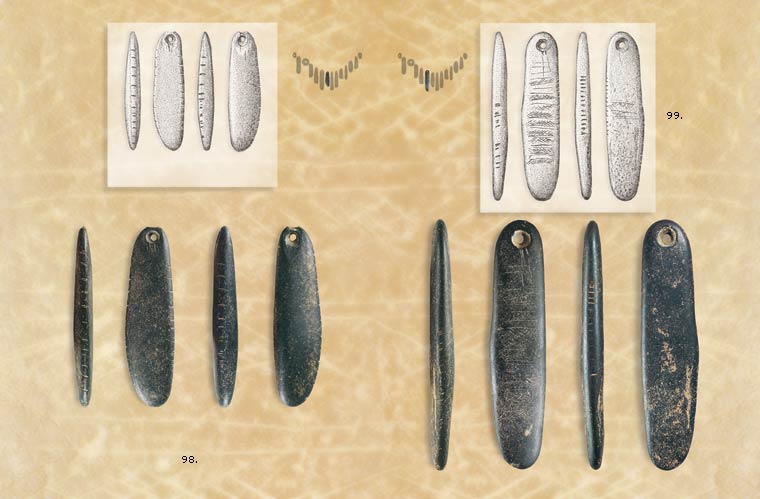
98. Not all stones display this same desire for perfect symmetry; some, indeed, are clearly more convex or even twisted on one side than the other, although we do not know whether the stones were especially chosen because of these shapes. 99. This pendant is decorated on all sides, but the most complex work is mostly found on one of the wider faces. There are parallel horizontal bodies or stripes of different width, alternating with a certain rhythm. The narrowest of these are undecorated and there are one or two “empty” ones between each decorated one. Of the decorated stones, the ones located at the two ends have very tight diagonal incisions, while the others have a reticulate motif created using lines running diagonally in both directions. © Jesús Alonso
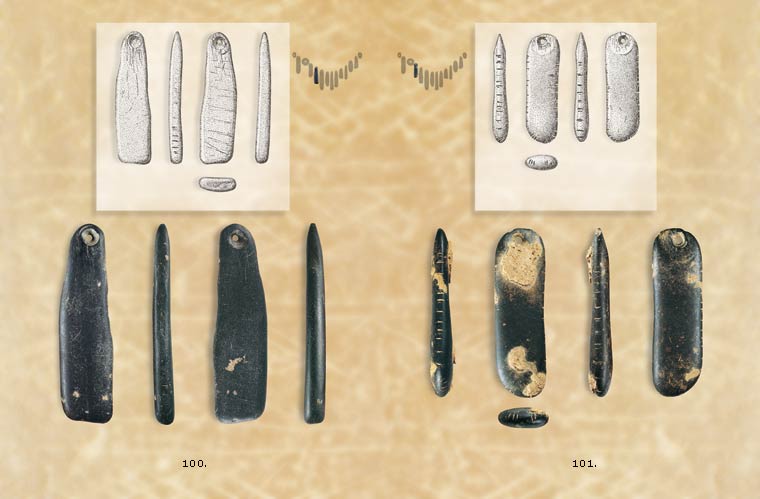
100. Several pendants have larger fine parallel lines forming stripes, generally symmetrical, on one or two of the faces. In many cases, these take up most of the surface. Unlike the narrow sides, the incision is very superficial. 101. One of the most striking features in the process of making some of these pieces is the way they were worn down around the perforation area. This tech-nique was often employed with bone, but it is very unusual on stone. © Jesús Alonso

102. This disc shaped limonite is noticeable for its varied greenish and reddish colouring, contrasting with the more uniform colours of the other pendants on the necklace. 103. Pendant with layers of concretion. © Jesús Alonso
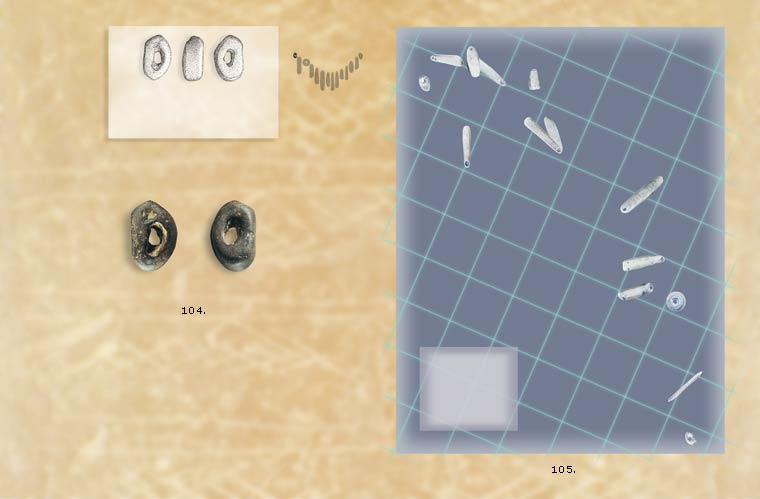
104. Small bead with natural hole situated at one end of a fourteen piece necklace. The symmetry sometimes seen in the decorations on the stones also extends to the way the pendants were arranged on the necklace, with two limonite stones of very similar shape and size positioned at each end. © Jesús Alonso 105. Arrangement of the fourteen pendants as they appeared in the inner room during excavations. © Xabi Otero

106. Partial view of the inner room of the cave. 107. Fifth set found in the cave, consisting of two stone pendants, one with a natural perforation. On occasions, smaller beads and ornaments, such as seeds or even feathers of different colours would have been hung between these items. © Xabi Otero
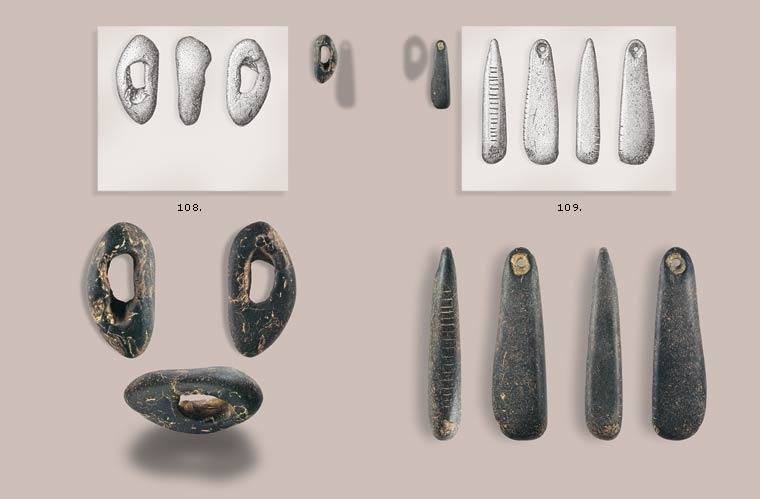
108. Some of the stones appear not to have been cho-sen for the regularity of their shape; for example, some were selected because they had a natural perforation which could be used. 109. Although many of these pieces have small parallel lines, this example is remarkable for the regularity, uniformity and clarity of the incisions. The opposite side, in contrast, contains no decoration. © Xabi Otero
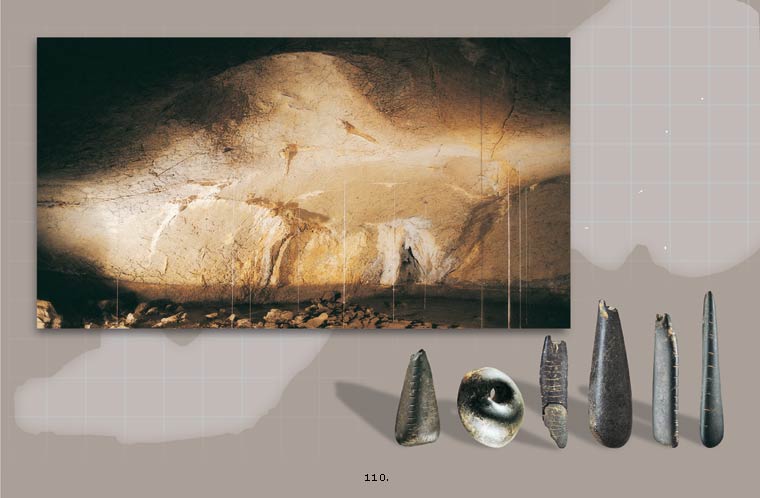
110. Walls and ceiling of the inner room. © Xabi Otero
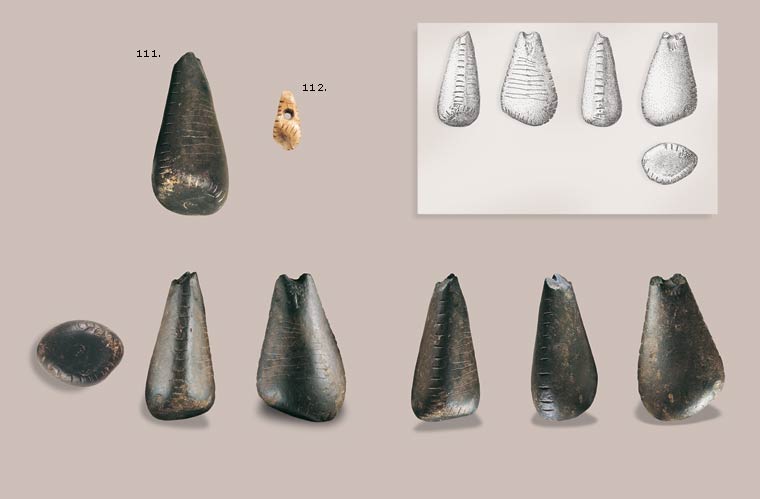
111. This pendant is notably similar to the atrophied canine tooth of a deer in shape, only bigger. All its edges are decorated, as is one of the side faces, with regularly spaced transverse lines. The perimeter of the largest base is also decorated. Atrophied deer canines were highly valued in many cultures, from the beginning of the Upper Palaeolithic practically down to the present, although not all of them were made into pendants. Imitations were also made from the earliest times in ivory or stones of varying colours (Gatzarria, El Pendo, etc.). Most of the natural specimens or imitations are plain, although some are decorated, generally with short lines. The decoration on the example from La Garma is very similar to that on the piece from Praileaitz I.
112. Perforated canine tooth from deer from the La Garma cave (Ribamontán al Monte, Cantabria). © Xabi Otero
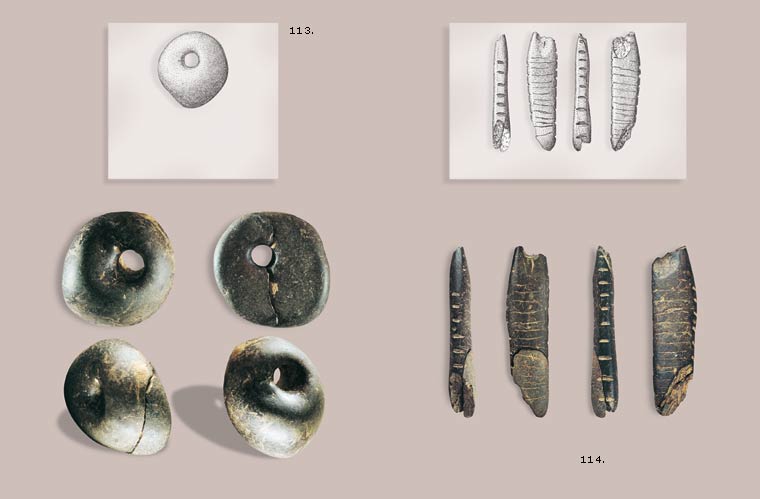
113. This large disc shaped stone, one of those selected with natural holes, is particularly interesting, with considerable doming on one face. It is not decorated. 114. All the planes of this pendant had very regular incisions. Unlike most examples with decorations on the broader faces, the lines on this pendant are deeper. This piece was found inside the cave during the excavation process, broken into two fragments, lying 13 metres from each other. © Xabi Otero
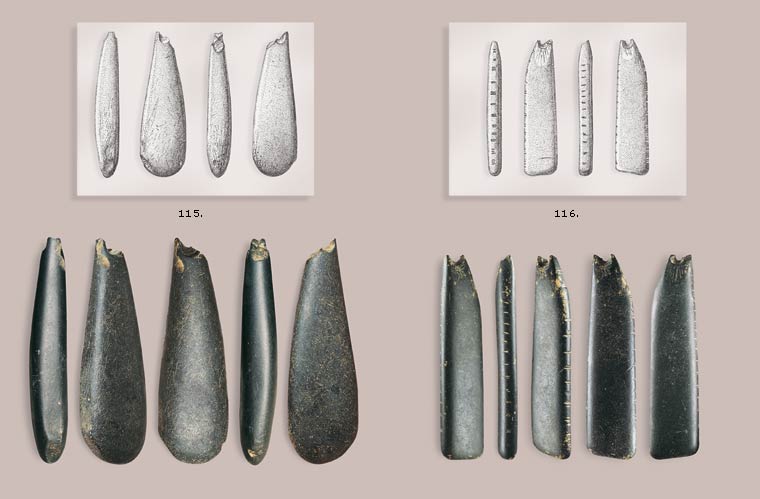
115. In some specimens the ends are very different. The one with the hole generally narrows slightly or is even pointed, to make it easier to drill. The opposite end is generally thicker to help the stone hang better. 116. In this elongated pendant, like some others, irregular incised points can be seen around the hole, caused by a sharp object. © Xabi Otero
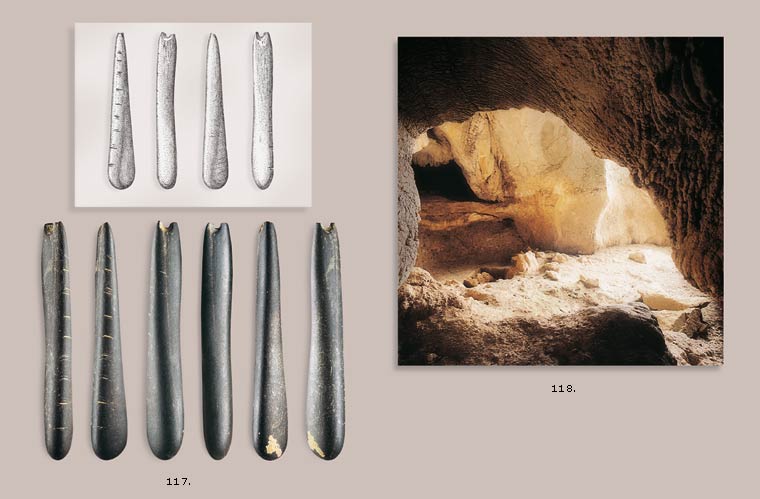
117. Despite the simplicity of this pendant, its natural appearance is quite striking: a long, narrow helicoidal shaped stone, which appears to turn on itself. This movement has been captured by the person who collected it and accentuated with a series of transverse lines at regular distances along the edges. 118. We gradually leave the gloom of the rooms in the cave, emerging into the bright light of the exterior. © Xabi Otero


